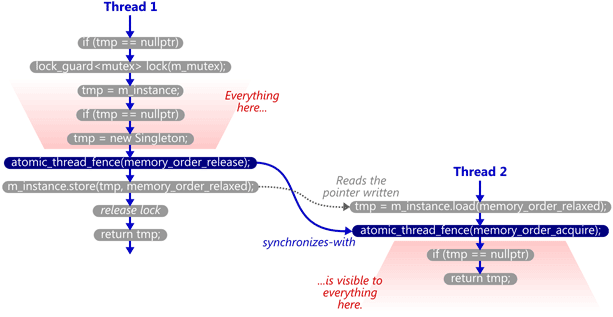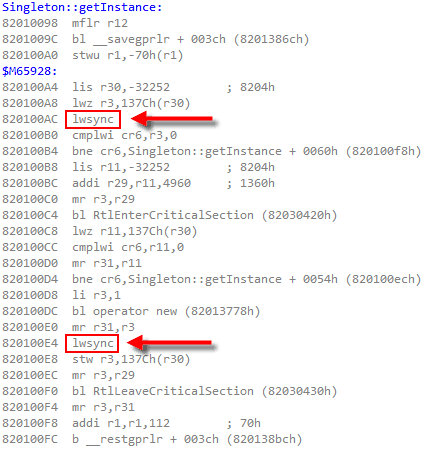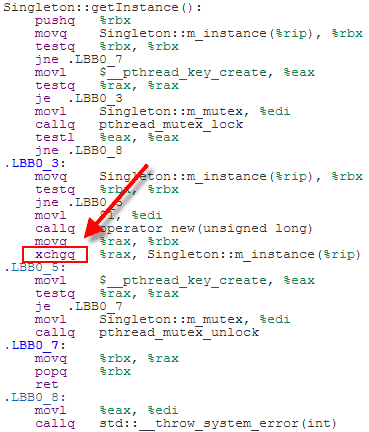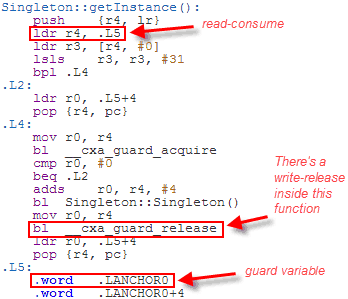Double-Checked Locking is Fixed In C++11
2015-06-28 12:15
489 查看
The double-checked locking pattern (DCLP) is a bit of a notorious case study inlock-free programming. Up until 2004, there
was no safe way to implement it in Java. Before C++11, there was no safe way to implement it in portable C++.
The pattern gained attention for the shortcomings it exposed in those languages, and people began to write about it. In 2000, a group of high-profile Java developers got together and signed a declaration entitled“Double-Checked
Locking Is Broken”. In 2004, Scott Meyers and Andrei Alexandrescu published an article entitled“C++ and the Perils of Double-Checked Locking”. Both
papers are great primers on what DCLP is, and why, at the time, those languages were inadequate for implementing it.
All of that’s in the past. Java now has a revised memory model, with new semantics for the
variety of portable DCLP implementations. C++11, in turn, inspiredMintomic, a small library I released earlier this year which makes it possible to implement DCLP on some older C/C++
compilers as well.
In this post, I’ll focus on the C++ implementations of DCLP.
Singleton pattern, and you want to make it thread-safe. The obvious approach is to ensure mutual exclusivity by adding a lock. That way, if two threads call
It’s a totally valid approach, but once the singleton is created, there isn’t really any need for the lock anymore.Locks aren’t necessarily slow,
but they don’t scale well under heavy contention.
The double-checked locking pattern avoids this lock when the singleton already exists. However, it’s not so simple, as theMeyers-Alexandrescu paper
shows. In that paper, the authors describe several flawed attempts to implement DCLP in C++, dissecting each attempt to explain why it’s unsafe. Finally, on page 12, they show an implementation whichis safe, but which depends on unspecified, platform-specific
memory barriers.
Here, we see where the double-checked locking pattern gets its name: We only take a lock when the singleton pointer
This is very close to a working implementation. It’s just missing some kind of memory barrier on the highlighted lines. At the time when the authors wrote the paper, there was no portable C/C++ function which could fill in the blanks. Now, with C++11, there
is.
acquire and release fences, a subject which I explained at length in my previous post. However, to make this code truly portable, you must also wrap
atomic operations. Here’s the resulting code, with the acquire and release fences highlighted.
This works reliably, even on multicore systems, because the memory fences establish asynchronizes-with relationship between the thread which
creates the singleton and any subsequent thread which skips the lock.

That’s what all those flawed DCLP implementations were missing: Without any
synchronizes-with relationship, there was no guarantee that all the writes performed by the first thread – in particular, those performed in the
itself was visible! The lock held by the first thread didn’t help, either, since the second thread doesn’t acquire any lock, and can therefore run concurrently.
If you’re looking for a deeper understanding of how and why these fences make DCLP work reliably, there’s some background information in myprevious post
as well as in earlier posts on this blog.
on the assumptions of the C++11 memory model – specifically, the absence ofout-of-thin-air stores – which is technically not
guaranteed by older compilers, but it’s the best we can do without C++11. Keep in mind that these are the circumstances in which we’ve written multithreaded C++ code for years. Out-of-thin-air stores have proven unpopular over time, and good compilers tend
not to do it.
Here’s a DCLP implementation using Mintomic’s acquire and release fences. It’s basically equivalent to the previous example using C++11’s acquire and release fences.
To implement acquire and release fences, Mintomic tries to generate the most efficient machine code possible on every platform it supports. For example, here’s the resulting machine code on Xbox 360, which is based on PowerPC. On this platform, an inline
is the
leanest instruction which can serve as both an acquire and release fence.

The previous C++11-based example could (and ideally, would) generate the exact same machine code for PowerPC when optimizations are enabled. Unfortunately, I don’t have access to a C++11-compliant PowerPC compiler to verify this.
to achieve the same effect in C++11 is to use atomic operations with low-level ordering constraints. As I’veshown previously, a write-release can
synchronize-with a read-acquire.
Technically, this form of lock-free synchronization is less strict than the form using standalone fences; the above operations are only meant to prevent memory reordering aroundthemselves, as opposed to standalone fences, which are meant to prevent
certain kinds of memory reordering aroundneighboring operations. Nonetheless, on the x86/64, ARMv6/v7, and PowerPC architectures, the best possible machine code is the same for both forms. For example, in anolder
post, I showed how C++11 low-level ordering constraints emit
One platform on which the two forms are likely to generate different machine code is Itanium. Itanium can implement C++11’s
Another such platform is the recently introduced ARMv8 architecture. ARMv8 offers
the default value is
sequentially consistent (SC) atomics. With SC atomics, the whole algorithm is guaranteed to appear sequentially consistent as long as there are nodata
races. SC atomics are really similar to
Here’s a DCLP implementation which uses SC atomics. As in all previous examples, the second highlighted line willsynchronize-with the first once the singleton is created.
SC atomics are considered easier for programmers to reason about. The tradeoff is that the generated machine code tends to be less efficient than that of the previous examples. For example, here’s some x64 machine code for the above code listing, as generated
by Clang 3.3 with optimizations enabled:

Because we’ve used SC atomics, the store to
would have done the job. It doesn’t matter too much, though, since the
On the other hand, if you compile SC atomics for PowerPC or ARMv6/v7, you’re pretty much guaranteed lousy machine code. For the gory details, see 00:44:25 - 00:49:16 of Herb Sutter’satomic<>
Weapons talk, part 2.
the contents of the singleton itself. In this case, the payload is considered a
data dependency of the guard pointer.
It turns out that when working with data dependencies, a read-acquire operation, which all of the above examples use, is actually overkill! We can do better by performing aconsume operation instead. Consume operations are cool because they
eliminate one of the
initializer.
[Update: Beware! As Rober Baker points out in the comments, this example doesn’t work in Visual Studio 2012 SP4. It only works in compilers that fully comply with this part of the C++11 standard.]
The C++11 standard’s got our back in §6.7.4:
If control enters the declaration concurrently while the variable is being initialized, the concurrent execution shall wait for completion of the initialization.
It’s up to the compiler to fill in the implementation details, and DCLP is the obvious choice. There’s no guarantee that the compiler will use DCLP, but it just so happens that some (perhaps most) C++11 compilers do. Here’s some machine code generated by
GCC 4.6 when compiling for ARM with the

Since the
read of this guard variable. The guard variable is a pointer to the singleton, and therefore the compiler can take advantage of the data dependency to omit the
As you can see, we’ve come a long way with C++11. Double-checked locking is fixed, and then some!
Personally, I’ve always thought that if you want to initialize a singleton, best to do it at program startup. But DCLP can certainly help you out of a jam. And as it happens, you can also use DCLP to store arbitrary value types in alock-free
hash table. More about that in a future post as well.
http://preshing.com/20130930/double-checked-locking-is-fixed-in-cpp11/
was no safe way to implement it in Java. Before C++11, there was no safe way to implement it in portable C++.
The pattern gained attention for the shortcomings it exposed in those languages, and people began to write about it. In 2000, a group of high-profile Java developers got together and signed a declaration entitled“Double-Checked
Locking Is Broken”. In 2004, Scott Meyers and Andrei Alexandrescu published an article entitled“C++ and the Perils of Double-Checked Locking”. Both
papers are great primers on what DCLP is, and why, at the time, those languages were inadequate for implementing it.
All of that’s in the past. Java now has a revised memory model, with new semantics for the
volatilekeyword, which makes it possible to implement DCLP safely. Likewise, C++11 has a shiny new memory model and atomic library which enable a wide
variety of portable DCLP implementations. C++11, in turn, inspiredMintomic, a small library I released earlier this year which makes it possible to implement DCLP on some older C/C++
compilers as well.
In this post, I’ll focus on the C++ implementations of DCLP.
What Is Double-Checked Locking?
Suppose you have a class which implements the well-knownSingleton pattern, and you want to make it thread-safe. The obvious approach is to ensure mutual exclusivity by adding a lock. That way, if two threads call
Singleton::getInstancesimultaneously, only one of them will create the singleton.
Singleton* Singleton::getInstance() {
Lock lock; // scope-based lock, released automatically when the function returns
if (m_instance == NULL) {
m_instance = new Singleton;
}
return m_instance;
}It’s a totally valid approach, but once the singleton is created, there isn’t really any need for the lock anymore.Locks aren’t necessarily slow,
but they don’t scale well under heavy contention.
The double-checked locking pattern avoids this lock when the singleton already exists. However, it’s not so simple, as theMeyers-Alexandrescu paper
shows. In that paper, the authors describe several flawed attempts to implement DCLP in C++, dissecting each attempt to explain why it’s unsafe. Finally, on page 12, they show an implementation whichis safe, but which depends on unspecified, platform-specific
memory barriers.
Singleton* Singleton::getInstance() {
Singleton* tmp = m_instance;
... // insert memory barrier
if (tmp == NULL) {
Lock lock;
tmp = m_instance;
if (tmp == NULL) {
tmp = new Singleton;
... // insert memory barrier
m_instance = tmp;
}
}
return tmp;
}Here, we see where the double-checked locking pattern gets its name: We only take a lock when the singleton pointer
m_instanceis
NULL, which serializes the first group of threads which happen to see that value. Once inside the lock,
m_instanceis checked a second time, so that only the first thread will create the singleton.
This is very close to a working implementation. It’s just missing some kind of memory barrier on the highlighted lines. At the time when the authors wrote the paper, there was no portable C/C++ function which could fill in the blanks. Now, with C++11, there
is.
Using C++11 Acquire and Release Fences
You can safely complete the above implementation usingacquire and release fences, a subject which I explained at length in my previous post. However, to make this code truly portable, you must also wrap
m_instancein a C++11 atomic type and manipulate it using relaxed
atomic operations. Here’s the resulting code, with the acquire and release fences highlighted.
std::atomic<Singleton*> Singleton::m_instance;
std::mutex Singleton::m_mutex;
Singleton* Singleton::getInstance() {
Singleton* tmp = m_instance.load(std::memory_order_relaxed);
std::atomic_thread_fence(std::memory_order_acquire);
if (tmp == nullptr) {
std::lock_guard<std::mutex> lock(m_mutex);
tmp = m_instance.load(std::memory_order_relaxed);
if (tmp == nullptr) {
tmp = new Singleton;
std::atomic_thread_fence(std::memory_order_release);
m_instance.store(tmp, std::memory_order_relaxed);
}
}
return tmp;
}This works reliably, even on multicore systems, because the memory fences establish asynchronizes-with relationship between the thread which
creates the singleton and any subsequent thread which skips the lock.
Singleton::m_instanceacts as the guard variable, and the contents of the singleton itself are the payload.

That’s what all those flawed DCLP implementations were missing: Without any
synchronizes-with relationship, there was no guarantee that all the writes performed by the first thread – in particular, those performed in the
Singletonconstructor – were visible to the second thread, even if the
m_instancepointer
itself was visible! The lock held by the first thread didn’t help, either, since the second thread doesn’t acquire any lock, and can therefore run concurrently.
If you’re looking for a deeper understanding of how and why these fences make DCLP work reliably, there’s some background information in myprevious post
as well as in earlier posts on this blog.
Using Mintomic Fences
Mintomic is a small C library which provides a subset of functionality from C++11’s atomic library, including acquire and release fences, and which works on older compilers. Mintomicrelieson the assumptions of the C++11 memory model – specifically, the absence ofout-of-thin-air stores – which is technically not
guaranteed by older compilers, but it’s the best we can do without C++11. Keep in mind that these are the circumstances in which we’ve written multithreaded C++ code for years. Out-of-thin-air stores have proven unpopular over time, and good compilers tend
not to do it.
Here’s a DCLP implementation using Mintomic’s acquire and release fences. It’s basically equivalent to the previous example using C++11’s acquire and release fences.
mint_atomicPtr_t Singleton::m_instance = { 0 };
mint_mutex_t Singleton::m_mutex;
Singleton* Singleton::getInstance() {
Singleton* tmp = (Singleton*) mint_load_ptr_relaxed(&m_instance);
mint_thread_fence_acquire();
if (tmp == NULL) {
mint_mutex_lock(&m_mutex);
tmp = (Singleton*) mint_load_ptr_relaxed(&m_instance);
if (tmp == NULL) {
tmp = new Singleton;
mint_thread_fence_release();
mint_store_ptr_relaxed(&m_instance, tmp);
}
mint_mutex_unlock(&m_mutex);
}
return tmp;
}To implement acquire and release fences, Mintomic tries to generate the most efficient machine code possible on every platform it supports. For example, here’s the resulting machine code on Xbox 360, which is based on PowerPC. On this platform, an inline
lwsync
is the
leanest instruction which can serve as both an acquire and release fence.

The previous C++11-based example could (and ideally, would) generate the exact same machine code for PowerPC when optimizations are enabled. Unfortunately, I don’t have access to a C++11-compliant PowerPC compiler to verify this.
Using C++11 Low-Level Ordering Constraints
C++11’s acquire and release fences can implement DCLP correctly, and should be able to generate optimal machine code on the majority of today’s multicore devices (as Mintomic does), but they’re not considered very fashionable. The preferred wayto achieve the same effect in C++11 is to use atomic operations with low-level ordering constraints. As I’veshown previously, a write-release can
synchronize-with a read-acquire.
std::atomic<Singleton*> Singleton::m_instance;
std::mutex Singleton::m_mutex;
Singleton* Singleton::getInstance() {
Singleton* tmp = m_instance.load(std::memory_order_acquire);
if (tmp == nullptr) {
std::lock_guard<std::mutex> lock(m_mutex);
tmp = m_instance.load(std::memory_order_relaxed);
if (tmp == nullptr) {
tmp = new Singleton;
m_instance.store(tmp, std::memory_order_release);
}
}
return tmp;
}Technically, this form of lock-free synchronization is less strict than the form using standalone fences; the above operations are only meant to prevent memory reordering aroundthemselves, as opposed to standalone fences, which are meant to prevent
certain kinds of memory reordering aroundneighboring operations. Nonetheless, on the x86/64, ARMv6/v7, and PowerPC architectures, the best possible machine code is the same for both forms. For example, in anolder
post, I showed how C++11 low-level ordering constraints emit
dmbinstructions on an ARMv7 compiler, which is the same thing you’d expect using standalone fences.
One platform on which the two forms are likely to generate different machine code is Itanium. Itanium can implement C++11’s
load(memory_order_acquire)using a single CPU instruction,
ld.acq, and
store(tmp, memory_order_release)using
st.rel. I’d love to investigate the performance difference of these instructions versus standalone fences, but have no access to an Itanium machine.
Another such platform is the recently introduced ARMv8 architecture. ARMv8 offers
ldarand
stlrinstructions, which are similar to Itanium’s
ld.acqand
st.relinstructions, except that they also enforce the heavierStoreLoad ordering between the
stlrinstruction and any subsequent
ldar. In fact, ARMv8’s new instructions are intended to implement C++11’s SC atomics, described next.
Using C++11 Sequentially Consistent Atomics
C++11 offers an entirely different way to write lock-free code. (We can consider DCLP “lock-free” in certain codepaths, since not all threads take the lock.) If you omit the optionalstd::memory_orderargument on all atomic library functions,
the default value is
std::memory_order_seq_cst, which turns all atomic variables into
sequentially consistent (SC) atomics. With SC atomics, the whole algorithm is guaranteed to appear sequentially consistent as long as there are nodata
races. SC atomics are really similar to
volatilevariables in Java 5+.
Here’s a DCLP implementation which uses SC atomics. As in all previous examples, the second highlighted line willsynchronize-with the first once the singleton is created.
std::atomic<Singleton*> Singleton::m_instance;
std::mutex Singleton::m_mutex;
Singleton* Singleton::getInstance() {
Singleton* tmp = m_instance.load();
if (tmp == nullptr) {
std::lock_guard<std::mutex> lock(m_mutex);
tmp = m_instance.load();
if (tmp == nullptr) {
tmp = new Singleton;
m_instance.store(tmp);
}
}
return tmp;
}SC atomics are considered easier for programmers to reason about. The tradeoff is that the generated machine code tends to be less efficient than that of the previous examples. For example, here’s some x64 machine code for the above code listing, as generated
by Clang 3.3 with optimizations enabled:

Because we’ve used SC atomics, the store to
m_instancehas been implemented using an
xchginstruction, which acts as a full memory fence on x64. That’s heavier instruction than DCLP really needs on x64. A plain
movinstruction
would have done the job. It doesn’t matter too much, though, since the
xchginstruction is only issued once, in the codepath where the singleton is first created.
On the other hand, if you compile SC atomics for PowerPC or ARMv6/v7, you’re pretty much guaranteed lousy machine code. For the gory details, see 00:44:25 - 00:49:16 of Herb Sutter’satomic<>
Weapons talk, part 2.
Using C++11 Data-Dependency Ordering
In all of the above examples I’ve shown here, there’s a synchronizes-with relationship between the thread which creates the singleton and any subsequent thread which avoids the lock. The guard variable is the singleton pointer, and the payload isthe contents of the singleton itself. In this case, the payload is considered a
data dependency of the guard pointer.
It turns out that when working with data dependencies, a read-acquire operation, which all of the above examples use, is actually overkill! We can do better by performing aconsume operation instead. Consume operations are cool because they
eliminate one of the
lwsyncinstructions on PowerPC, and one of the
dmbinstructions on ARMv7. I’ll write more about data dependencies and consume operations in afuture post.
Using a C++11 Static Initializer
Some readers already know the punch line to this post: C++11 doesn’t require you to jump through any of the above hoops to get a thread-safe singleton. You can simplyuse a staticinitializer.
[Update: Beware! As Rober Baker points out in the comments, this example doesn’t work in Visual Studio 2012 SP4. It only works in compilers that fully comply with this part of the C++11 standard.]
Singleton& Singleton::getInstance() {
static Singleton instance;
return instance;
}The C++11 standard’s got our back in §6.7.4:
If control enters the declaration concurrently while the variable is being initialized, the concurrent execution shall wait for completion of the initialization.
It’s up to the compiler to fill in the implementation details, and DCLP is the obvious choice. There’s no guarantee that the compiler will use DCLP, but it just so happens that some (perhaps most) C++11 compilers do. Here’s some machine code generated by
GCC 4.6 when compiling for ARM with the
-std=c++0xoption:

Since the
Singletonis constructed at a fixed address, the compiler has introduced a separate guard variable for synchronization purposes. Note in particular that there’s no
dmbinstruction to act as an acquire fence after the initial
read of this guard variable. The guard variable is a pointer to the singleton, and therefore the compiler can take advantage of the data dependency to omit the
dmbinstruction.
__cxa_guard_releaseperforms a write-release on the guard, is thereforedependency-ordered-before the read-consume once the guard has been set, making the whole thing resilient against memory reordering, just like all the previous examples.
As you can see, we’ve come a long way with C++11. Double-checked locking is fixed, and then some!
Personally, I’ve always thought that if you want to initialize a singleton, best to do it at program startup. But DCLP can certainly help you out of a jam. And as it happens, you can also use DCLP to store arbitrary value types in alock-free
hash table. More about that in a future post as well.
http://preshing.com/20130930/double-checked-locking-is-fixed-in-cpp11/
相关文章推荐
- 在 Qt4 中使用 C++11
- 使用eclipse编译含有C++11特性的代码
- eclipse支持c++11
- C++11可变参数函数与for循环
- vs2013 编译c++是发现惊天bug
- 关于C++现状的一些思考
- 用C++11优化矩阵运算的空间和时间效率
- 浅析构造函数之默认构造函数
- c++中返回数组的函数
- C++函数重载的几个问题
- C++11 现代C++风格的新元素
- c++11 lambda表达式浅谈
- C++11之“move”语意
- C++11之Lambda表达式
- C++11特性乱弹
- 掀起C++ 11的神秘面纱(1)
- 掀起C++ 11的神秘面纱(2)
- Pascal's Triangle II
- lamda 函数 (or 表达式)
- C++11新特性
